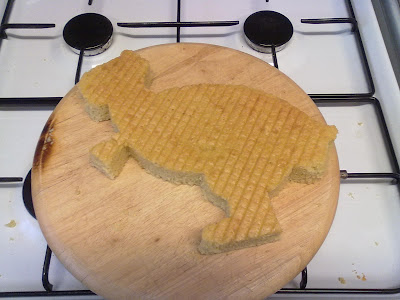Ok, so maybe it's lazy to do another bean bag post, but I have made another one, so why not eh?!
This time, the bean bag was for Joshua, and this is how it went...
Go to fabric shop to find fabric.
Fail to find it and resort to asking shop lady.
Follow shop lady to the (very) limited selection of kiddie fabric, but breathe a huge sigh of relief on discovering that there is some pirate fabric.
When asked how much you want, think to yourself, "oops, should probably have thought about this" and ask for three metres as a wild guess.
Thank the lady kindly when she gives you an extra end bit.
(I'll now skip ahead to the 'making' bit, so you don't have the
whole day)
Think, "why bother with circles and trapeziums (see last bean bag), surely squares and rectangles will do"
Cut out two squares the same size. (If you're a 'details' kinda person, you might be interested to know mine were 70 cm square, but that's only because the fabric was 140cm wide and I didn't want to be wasteful)
Cut out four rectangles which have two sides the same length as the square sides. (again, 'details' - the other sides were about 56 cm. And when I say 'about' I really mean it - more of that later)
Start pinning bits together.
I pinned two bits to the top square first (I reckoned the top one was the more important to get right - if your fabric's got a right way up and a wrong way up, make sure it's the right way up)
Sew the bits on.
Realise that one of the bits you've just sewn onto the top square is, sadly, the bottom square.
Curse your own ineptitude
Turn your back briefly on your three-year-old (yes, I had my 'helper' again) only to turn back round and discover he's just cut one of the rectangles into bits. And yes, it was the one I'd already sewn on.
Chastise child (I'm not going into details here!)
Unpick shredded rectangle from top square. (Cursing child)
Unpick bottom square from top square. (Cursing yourself)
Realise you have lunch guests coming.
Do lunch (meanwhile, child, in his grief, has fallen asleep for an early nap)
Head back upstairs after lunch and look forlornly at shredded (and now unpicked) rectangle.
Vow that this can be redeemed.
Find cushion in cupboard that's just the right size.
Trim off all 'shredded' bits of the rectangle.
Turn shredded bean bag rectangle into new-life cushion cover with a quick run on the machine.
Wake child to show him your cushiwork, make up after the early disagreements and play.
(Skipping ahead again)
Start over with the pinning.
Realise you could have used two rectangles rather than four, and not bothered cutting them in half. (Depending on mood, either smile or feel glum about this)
Start sewing.
Make sure you get a zip in there somewhere (I did it between the bottom and one side)
Wonder why you weren't more careful with your measuring, as the corners now don't really match up very well at all.
Steal the inside of another bean bag (otherwise the beans will all fall out of the corners that, as mentioned, haven't really worked...)
Fill the bean bag. Bear in mind that if you overfill a bean bag, you end up sitting on top of it, rather than sinking into it as you should!
Show bean bag to child.
Be thankful that he's thankful. (On that note, he's rather gone off Charlie and Lola - it's all Fireman Sam at the moment - if he thinks I'm doing another painting on his wall, he's got another think coming!)

If you're feeling adventurous, try out
this once you're done.






























